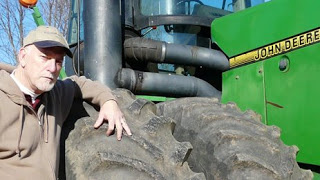Newspapers, farms and Bud’s advice

When the Tribune Co. announced bankruptcy in December, I had one immediate thought:
I wish they’d really bought the farm.
The World’s Greatest Newspaper is broke and an uncomfortable crowd of metros is teetering on the brink. Even the New York Times is hocking its skyscraper to pay the bills.
It’s a sad time for those big broadsheets we traditionally use to define “newspaper.” Here in academia, out in the blogosphere and certainly in the corporate boardrooms, the fear is palpable and the dream of an online white knight ubiquitous.
But I keep thinking of the farm.
Out in the Heartland, the papers that report on the 8th Grade Softball Championships and PTA chicken dinners also are hurting. Hurting, but not dying.
The National Newspaper Association and the Suburban Newspapers of America recently reported that revenues for papers with under 100,000 circulation are down nearly 2%. That’s tolerable. The total newspaper industry is down 18%.
The metros are dreaming of a federal bailout. The community publishers have hunkered down and are waiting for another storm to pass.
I learned my key lessons in newspaper economics while working as the general manager of the East Oregonian, a small daily in the namesake town of Pendleton wool. There are still sheep in the hills, but Pendleton is surrounded by those amber waves of grain that encourage God to shed his grace on thee. Dryland wheat farming is a bigger gamble than the stock market – only half your land produces a crop each year and the cash you get back depends on the current popularity of sandwiches and ramen noodles.
But like the East Oregonian, most of those wheat fields have been tended by the same families for generations. That, I learned, is the key to the historic success of the American press.
Newspapers are farms, not factories.
Manufacturing is a highly volatile industry. It takes a constant flow of new capital to develop those new and improved products, to buy and replace ever-changing machinery and to keep the foreign competitors at bay. Ergo the stock market, where investors bet you can appear to promise enough success to edge the value of their shares up a few points next quarter.
Those investors don’t turn the cranks nor staff the assembly line. They impatiently snipe from the sidelines for greater and greater quarterly gains to drive up the price of their stock.
I thought Knight-Ridder’s a 19% profit margin sounded pretty darn good, but Wall Street forced its sale to drive up its stock value. Even in these times of misery, Gannett reports a 9% net profit (down from the mid 20s).
By comparison, Wal-Mart posts a 3% profit, down from about 6%. But the happy face is still on those discount stickers.

In Oregon I came to appreciate patience. On farms there are no fiscal quarters, only crop seasons. Anyone with soil beneath their fingernails knows droughts will take their rotation with bumper crops. That’s what barns, haylofts and grain elevators are for.
Newspapers once shared the economic strategy of the farms. They delighted in being among the oldest continuing businesses in their regions. Families owned them and, like farms, they were passed down from generation to generation. Publishers felt they both owned their communities and the communities owned them. They expected there would be lean years when they ate beans with the farmers and boom years when they shared brandy with the bankers.
In their quest to keep up with the factories, big media borrowed heavily to buy more and more papers they could run with journalistic sharecroppers. The addition of that heavy debt load was never part of the successful farm/newspaper economy. The drought hit in a big way and the notion of a quarterly gain became a joke.
But a newspaper, like a farm, must exist over a span greater than a fiscal quarter.
I will never forget the pleasant shock I had when I was introduced to Bud Forrester, the septuagenarian patriarch of the family that owned the East Oregonian.
“Clyde, just give me a new car and maybe a trip to Hawaii. But take care of my newspaper.” He shook my hand, smiled and walked away.
I had the good sense and the good skills deliver more than that. When a friend faced the ax because his chain paper’s profit dropped below 20%, I rejoiced that but-for-the-grace-of-Bud, there went I.
Bud Forrester is gone and I no longer ride herd on the East Oregonian. This year I wouldn’t be surprised at all if his grandchildren are making do with not-so-shiny cars. But the season will change.
And they’ll get that trip.
